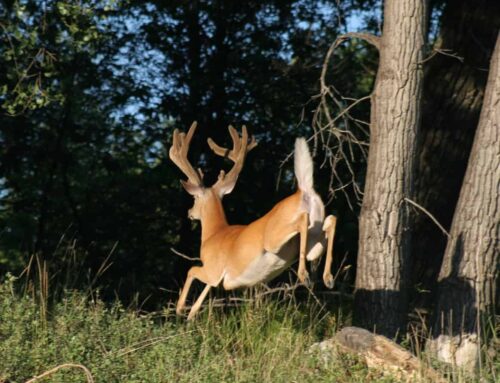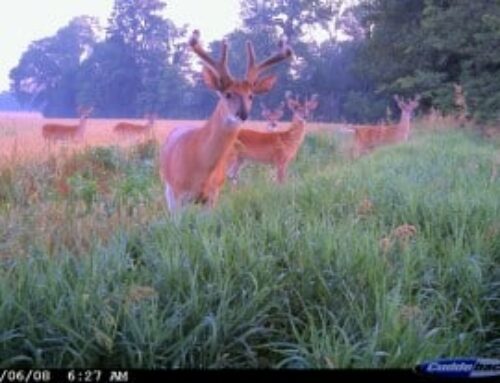Today’s guest blog is from Wisconsin hunter and friend of BIG DEER Kim Redburn:
Did you know that a whitetail buck will check and freshen a scrape year-round?
Four years ago I started running 6 trail cameras 365 days a year on my land, as I really enjoy the wildlife and the change of seasons they capture. Being a hunter with 40 years of experience, I didn’t think I would stumble onto some deer behavioral habits I was not aware of. But I did.
Initially when I purchased my small wooded property I completed an extensive walk of the land in early spring. I found several trails, a few small rubs and scrapes and 2 larger scrapes that I call “breeding scrapes.” These large scrape spots were the first 2 places I placed cameras. Two cameras were placed along prominent deer trails, and the last 2 cams were delegated security to watch the camper and the gate.
After a couple of years of constant monitoring, the pattern of bucks coming to freshen the large scrapes year-round became evident. That is when I began experimenting with making mock scrapes, but like most hunters I would wait until fall, just before the upsurge in scraping begins, to do it.
But turns out that might not be the best time for mock scrapes. I had some success, but since then I have found early summer to be the ideal time for making mock scrapes.
Here’s how I do it.
First is location selection. If you’ve been hunting real buck scrapes over the years and are tired of getting busted there, start making mock scrapes in places that benefit you, not the deer.
For years I think I may have put my stands in spots that did not have the stealth I needed to get in and out, which may have compromised my opportunity. This year I found a new tree stand location overlooking an area of mixed oaks and poplar that I can sneak to and away from easily. I am taking a chance here because the closest trail is only 50 yards away, but from the tall oak I have a good lane of visibility, which is another reason I chose the tree. And this is where I built my latest mock scrape.
If it seems I’m doing things backwards—choosing a tree and then a place to scrape–well I am sort of, but that is how much I believe in my mock scrape making. Again, the key is the location of it.
While any dirt will do, the best mock scrapes start out with some soil and deer droppings that you collect at an existing scrape if you can find one (once you create a mock scrape in a place you really like, you can collect urine-soaked soil and droppings from real scrapes later this fall and add it to your scrape).
You will need a dripper system with a “scrape starter” solution. I use Wildlife Research Center, but there are other products out there. Note: Do not use doe in heat or an estrus scent at this time in the summer.
You’ll need a 3-prong hand rake, a trowel and a plastic bag. Rake an existing scrape down to bare soil, and trowel a fair amount of the dirt, about 3 to 5 pounds, into the bag.
Carry the dirt to the spot where you’ll make your scrape, which must be below a prominent overhanging “lick or chew” branch that bucks will most definitely use. The branch should be at approximately 4 feet high–never touch it!
Your mock scrape is not only scent-based but also a visual sign, so rake out at least a 2 foot by 3 foot area below the overhanging branch. As I rake, I envision a buck. He scrapes with his hooves primarily in one direction, and your raking should be done the same way, leaving the debris on the back side of the scrape.
Without stepping into the middle of your scrape, hang your empty dripper on a limb above the chew branch where scent will drip and land in the scrape. Now spread your collected soil evenly across your scraped-out area. While this deer-scented dirt is not necessary, it adds realism and makes for a quicker and a more consistently attended scrape.
Fill your dripper with scrape-starter solution and make sure it’s dripping a bit. Place your trail camera nearby and enjoy the images you’ll get until hunting season opens.–Kim
About the buck photos above: Kim’s cameras captured both these bucks working her mock scrapes and chew branches earlier this July, proof her tactic works!









Interesting article, Kim. I just want to add one little trick that I learned from Sam Collora. He will actually take a small, clean shovel and remove some of the existing dirt and put down a large piece (or two) of wax(ed) paper, and then replace the dirt over the top of the fake scrape. He reasons that the wax paper will help urines stay in that scrape longer. I think your idea of placing dirt/droppings from other existing scrapes on top of the dirt after putting the wax paper down would make it even more “desirable” to the deer. I love using mock scrapes (especially in my decoy setups. I picked up some new info. and ideas today. Very cool, Kim. Thanks Hanback.